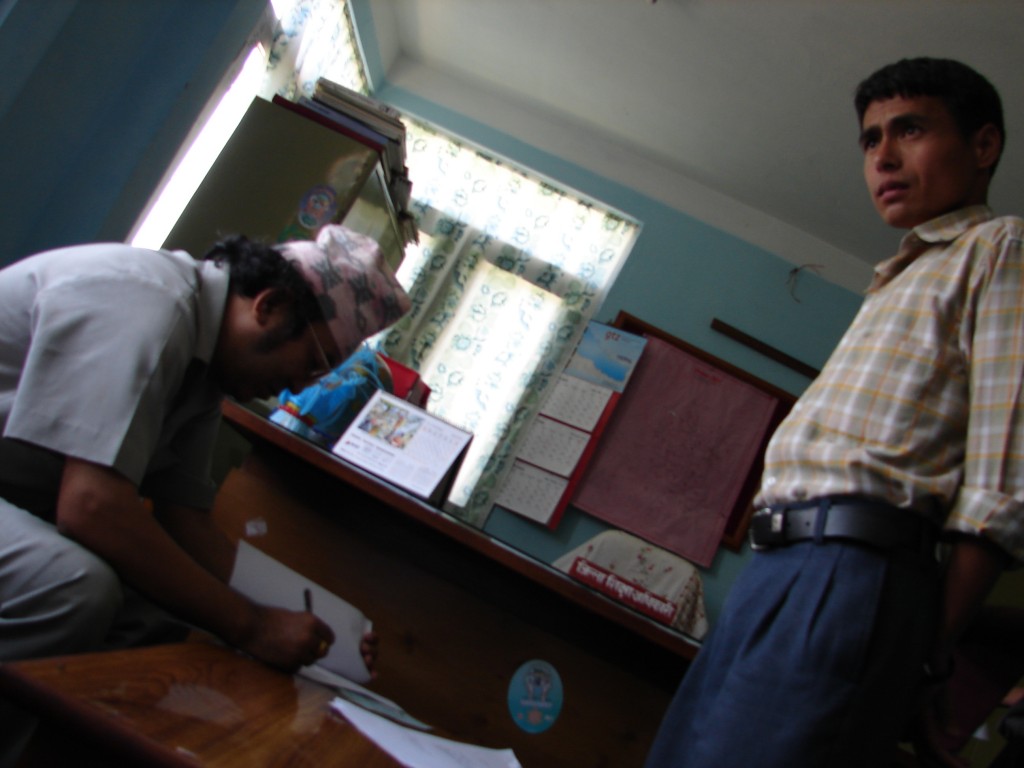
Local bodies lack staff but still get more tasks from the federal government: district-level staff (Photo: LNT).
Most provincial and local governments remain desperately short of staff. However, the federal government is coming up with still more programmes for the local bodies to implement! Just over the last few days, two major government initiatives have landed on local mayors’ desks.
First is a programme which to our knowledge is unprecedented in Nepal, although something similar may have existed under the Panchayat System. The government wants the local bodies – from municipal down to ward level – to form so-called “community-security committees”.
Some 360 such committees have already been formed by the police under a Home Ministry reform plan. But the initiative has stalled, so the Ministry of Federal Affairs and General Administration has ordered all municipalities to help the police reboot the programme.
The community-security committees are to be created under a new “Community-Police Partnership Programme”, and the ministry has ordered the local bodies to start implementing it at the earliest with the police at district, municipal and ward level. So, what are the tasks?

Little staff, more tasks: local bodies need to form community security committees with the police (Photo: Save the Children).
The local bodies are to include government and non-government organisations in the security committees as well as “non-political” community and social organisations, such as associations working with women’s and children’s rights, local public schools, and prominent local persons.
The local bodies must also call monthly security committee meetings, organise at least two district-wise awareness programmes, select and mobilise volunteers, and install CCTV cameras and security sirens locally. They even need to keep track of local people, reads the order:
“The partnership programme envisages [the creation of] record-keeping systems of persons living at neighbourhood and community levels to prevent crimes and arrest absconded crime suspects.”
Add to that the tasks of detecting women trafficking, child marriage and dowry, and it’s no small job at all!
The other new government programme being handed down to the generally understaffed local bodies is called “Strategy for Resilient Local Communities, 2018”. Under this programme, the local bodies need to make themselves capable of handling any new disaster situation.
In the first phase of the programme, the local bodies are required to identify vulnerable areas, relocate vulnerable individuals and households to safer places, ensure availability of necessary medicine, food and rescue equipment, and arrange for insurance of crops and livestock.

Important task but little staff: local bodies must step up their disaster preparedness and management capability.
Then, the local bodies are to be trained to undertake damage assessment, data collection and need assessment after a disaster, to carry out search and rescue operations, distribute goods, services and cash to affected persons and households, and repair basic infrastructure.
In the third phase of the programme, the goal is to make local bodies capable of mitigating the vulnerabilities of local communities to anything from earthquake and landslides to effects often associated with climate change, such as prolonged drought and floods. Quite a lot, too!
It’s not unusual to involve local governments in anything from making communities more secure to strengthening disaster management and preparedness. But if these initiatives are to be implemented well, the local bodies will need requisite resources, such as adequate staff.
So far the local lack of staff – known as the “staff crunch” – is nowhere near a solution. Moreover, the urgency with which the government is launching new programmes stands in contrast to a less speedy effort in solving the staff issue at provincial and local level.

Recently at the centre of discontent with a half-hearted effort to solve the staff crunch: minister of MoFALD, Lal Babu Pandit (photo: THT).
It’s in fact a classical aspect of relations between central and local government: a tendency to confer many tasks and responsibilities to the local level without providing adequate resources – such as staff and budgetary resources – to enable their effective implementation.
In addition, sometimes a central government may turn local bodies into implementing agencies of government programmes rather than enabling them to function along the principles of autonomous local self-government: to let them form their own programmes.
Is the federal government treating the local bodies as its implementing arm, handing down programmes as though the local governments were their frontline agencies rather than autonomous local bodies? Or is the government merely trying to carry out its national policies?
Well, the relationship between federal and local government in Nepal is still in the making. The degree to which local bodies become local self-government bodies in practice will depend on resources such as staff and the extent to which they are allowed to shape their own activities.
The status at this point? So far, several programmes handed down by the federal government for local bodies to simply implement, and an apparent lack of urgency in solving the staff crunch that still faces local bodies across the country in general, leaves a mixed picture.

